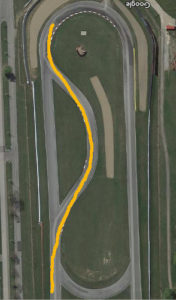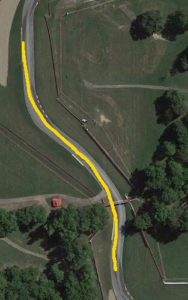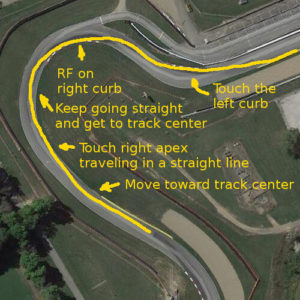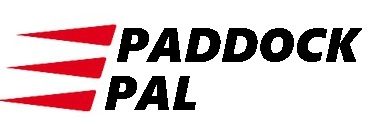
Mid-Ohio Sports Car Course is a road course auto racing facility located in Troy Township, Morrow County, Ohio, United States, just outside the village of Lexington. The track opened as a 15-turn, 2.4 mile (3.86 km) road circuit run clockwise. The back portion of the track allows speeds approaching 180 mph (290 km/h). - Learn more on: Wikipedia
NOTE: This is a dynamic page, if this page is not displaying any data, please use the TRACK GUIDE menu to reselect this venue!
| Travel Guide | Turn-by-Turn |
Paddock
- Drop off times for cars/trailers is generally 6pm the evening before an event.
- PADDOCK IS CLOSED AND LOCKED BY 8pm. NO CAMPING.
- Restrooms are located at the end of the garages by the Control Tower; there are also PortaPotties spread throughout the upper/lower paddock.
- Food is only available on site if concessions are open.
- Gas pumps are located at the Fuel shed between the upper/lower paddocks.
Passing Zones
Note: All passing zone data depicted below is based on "advanced driver" rules, if you are in a different run group please consult your organization or chief instructor for passing zones that are appropriate for your run group.
No Passing Zone information is currently available.Turn-by-Turn
- Turn 1: A fast left hand sweeper, this turn sees the full spectrum of entries from full power to moderate, if brief, braking.Low power, high grip cars can enter turn 1 under full throttle. The turn in point is just past the 100 brake marker for such an entry:
 The curbing separating the pit exit from track surface seems tall at first but, like all the other curbing at Mid-Ohio, has a "ramp" leading into it - the first tile is buried at an angle and has no step. As a result, getting onto that curbing right where it begins is not too upsetting to the car. Entering the curbing elsewhere is best avoided as those entries do have a pronounced step.The curbing should be entered with the left front tire along the path indicated by the red line below:
The curbing separating the pit exit from track surface seems tall at first but, like all the other curbing at Mid-Ohio, has a "ramp" leading into it - the first tile is buried at an angle and has no step. As a result, getting onto that curbing right where it begins is not too upsetting to the car. Entering the curbing elsewhere is best avoided as those entries do have a pronounced step.The curbing should be entered with the left front tire along the path indicated by the red line below:

Using the inside curb in turn 1 seems especially suited to low power, high grip cars with their early turn in point. More powerful cars turning in later will probably not be able to enter the curbing smoothly.
Once on the apex curbing, do not drop a wheel on the inside of it (the pit exit side). Getting the left rear tire off the curb in that fashion tends to immediately send the car into a drift.
Instead run off the curbing on the right side as the car starts to track out.
Low power cars should use the entire track at the exit including the entire exit curb. The grass at the exit is friendly and can be taken in favor of a lift on a hero lap.
High power cars will be braking meaningfully prior to turn 1 and will have a much later turn in point. End of the bridge is a good choice for really powerful cars. Cars with a lot of grip and a lot of power may want to enter a bit earlier and carry more speed into the turn, especially if the chicane is used. Conversely if the chicane is not used turn 1 should be all about a late apex and good exit in high power cars.
- CHICANE: Like in turn 1, a great variety of entries and lines are possible based on the power and grip level of the car.Low power, high grip: full power 2/3 through the chicane, when in the last third start to brake to settle the car for turn 2 entry. Turn in for the chicane is around the "250" brake marker (half way between 200 and 300 markers).Low power, medium grip: brush the brakes around the middle of the chicane to tighten up the line and get to the second left apex. Turn in point for the chicane closer to the 200 brake marker.High power: brake early in the chicane to get the speed through the middle down to a manageable number, try to carry that speed through the exit. I'm thinking it should be possible to enter the chicane without braking, either with a lift or under power even in a medium to high power car. Turn in point for the chicane likely at or past the 200 brake marker.
Virtually all cars should touch the second apex curbing in the chicane. Getting on that curbing is probably unnecessary as it would point the car too far left entering turn 2. The first apex curbing in the chicane is irrelevant, and will most likely be missed.

- Turn 2 "KEYHOLE" + CHICANE:This is an off camber, very long, late apex right with an uphill entry and downhill middle and exit.Given how long the turn is, overbraking for it costs a good amount of time as even low power cars are unable to start accelerating too early. The goal in turn 2 is to carry good speed into the turn from the preceding straight, get the car rotated either on entry or mid turn, and be on throttle at the right time but not too soon.Turn 2 lends itself very well to driving by feel. The entry, being over a crest, unloads the car while the car also transitions from a left curve into a right curve. In my opinion keeping the car on the edge of grip while varying the line as necessary is faster than sticking to a particular line but giving up entry and cornering speed as a result.
All cars should touch the right side curbing at the entry into turn 2 under moderate braking transitioning into trailbraking. Then, the low power cars will swing wide (toward the left side of the track) about 1/3 of the way into turn 2, while high power cars will swing wide about 2/3 of the way into the turn. In low power cars the leftmost point on the line is where trailbraking will be completed and the car will be rotated to face the exit. In high power cars the braking zone may need to be stretched to maintain weight over the front tires at the rotation point.
From the rotation point onward, all cars should be under increasing throttle, achieving full throttle as early as possible. Decreasing throttle (lifting) past initial throttle application means the car did not swing wide enough for its power level, did not rotate enough (insufficient weight maintained over the front tires) or tried to rotate too soon (similarly to having an early turn in point, subject to the formal turn in point for turn 2 being around the right side curbing on the uphill side).
- Turn 2 w/o CHICANE: I have not driven this configuration but my feeling is it will be easier to drive than the configuration with the chicane. Without the chicane the car will be going faster into turn 2, requiring more braking; however, the braking will be done in a straight line and the approach angle into turn 2 will be more favorable. Drivers of high power cars especially should have an easier time going into turn 2 without the chicane. In any event the turn will remain a heavy trailbraking turn with the same wide swing somewhere in the turn itself followed by early throttle application for the exit.
- Turn 3: The kink on the back straight, I am pretty sure it is taken under full power in virtually everything. I suggest touching the apex on the right side at some point to drive the least distance.
- Turn 4: With the famous China Beach sand trap on the outside of turn 4, the turn should be taken conservatively. Or should it? The track is plenty wide as well as substantially banked through the first half of the turn, and a good amount of speed can be carried to and through the apex, making turn 4 very certainly an entry speed turn where a healthy dose of aggression will be rewarded by a nice reduction in lap time.Due to the banking and the entry speed nature of the corner, turn 4 calls for heavy trailbraking. Most cars should be braking up to the apex. The apex curbing is very usable and is good for an extra 1-2 feet of track width.Braking point for turn 4 depends heavily on the car's power level and the only thing I will say is that with proper trailbraking, the braking point is much later than one might first think. Turn in point varies as well; lighter and lower power cars can start bending their line into the turn at around 150-125 brake marker, with heavier and higher power cars probably being better served by something in the neighborhood of the 100 brake marker.Track out all the way left while maintaining partial or full throttle depending on the car's grip and power level.

- Turn 5 "MADNESS": A left hander cresting a sizeable hill with an off camber exit and an entry on the inside, turn 5 well deserves its moniker "Madness". I consider this corner one of the most challenging, if not the most challenging, corners on the East Coast. The off camber exit has low tolerance for errors hence precision on entry is crucial. At the same time the entry is anything but straight as the car must transition from a right curve coming out of turn 4 into a left curve while going through a compression point. Carrying speed over the blind crest takes some getting used to as well, bearing in mind that the faster the car is going there the more it will move laterally as the suspension unloads over the crest.In a low power car I found an entry on the left half of the track to work best. Especially if taking turn 4 at a high speed, there is simply not enough spacing between turns 4 and 5 to get the car over to the right before the turn in point for turn 5. Additionally, track surface is crowned and the left half of the track is in camber while the right half of the track is a bit off camber. With good grip an entry just right of the left edge of the track works well.Touch or go on the left side curb just past the point where it begins.The car should crest the hill roughly at track center, and this is a good time to begin opening the steering wheel and applying power. The car should track out all the way to the curbing on the right side on the downhill. If you do not need to track out that far, enter Madness faster but build the speed slowly.
Continue the left turn at the exit of turn 5 to come over all the way to the left edge of the track by the turn in point for turn 6.

High power cars will want a deeper entry into turn 5, rotate the car more on the uphill and be more parallel to the track over the crest as a result. The driver should start opening the wheel prior to the crest and crest with small steering angle under light throttle. Getting the car over on the left edge of the track for turn 6 is probably also applicable to high power cars. - Turn 6: A right hander made difficult by the downhill entry and the fact that the turn itself is about 100 degrees of direction change.The entry into turn 6 is on the left edge of the track, hence transitioning from track right to track left immediately after exiting turn 5 is critical for driving turn 6 properly.The turn in point for turn 6 in a low power car is just before the dark patch running throughout the turn. In a high power car the turn in point will probably be just past the beginning of said patch.All cars should touch the right side curbing at the apex or go over it - missing this curbing typically means the driver started braking too late and consequently turned in too late. The downhill entry requires an earlier turn in than would be expected had the turn been flat.
Low power cars should track out all the way left when exiting turn 6, as they will still be able to make turn 7. Tracking out to the left edge of the track where the apex curb in turn 7 begins works well. High power cars may need to get to track center between turns 6 and 7 either by not tracking out all the way left or moving back right.

- Turn 7: A medium speed left hander transitioning into an uphill.Low power cars can turn in almost from the left edge of the track and run over the left side curbing to get the correct angle for the transition between turns 7 and 8 and then try to run somewhat of a straight line from the apex of turn 7 to the beginning of the left side curbing between turns 8 and 9. This line should crest the hill in turn 7 roughly mid track.High power cars will want to turn in later because they will be cresting with less steering angle and their line through turn 8 will be more straight. Essentially high power cars will have more curvature in their line in turn 7 entry and less in turn 7 exit, compared to low power cars.

- Turn 8: A more open right hander, turn 8 is really the transition between turn 7 and turn 9. Low power cars can maintain full throttle through turn 8 while curving their line to fit into the track; high power cars will likely need to make the line through the turn itself mostly straight and angled further clockwise to set up better for turn 9.It is not necessary to touch the right side curbing at the apex of turn 8.
- Turn 9: A blind right hander over a crest, turn 9 is important to get right because it is followed by a decently long straight. The turn is made challenging by the off camber exit with not much runoff, rather low grip at the turn in point due to patches and sealer and a fairly steep, but still usable, apex curb.Setting up for turn 9 is critical, and in the suggested order of execution it involves:
- Having the car parallel to the left side curb between turns 8 and 9;
- Having the car on the left edge of the track at said curb;
- Turning in at the correct point which is neither too early nor too late.
Inexperienced drivers commonly turn in from the center of the track with the car facing away from the corner and are either too early or too late. To take turn 9 properly:
- When coming out of turn 8, aim at the beginning of the left side curb. Aiming at the middle of the curb is generally too late and will result in the car still driving away from turn 9 by turn 9's turn in point.
- Drive out all the way to the curb, which is also the left edge of the track, at the beginning of the left side curb. Doing so will force the car to follow the left curb parallel to the track, completing direction change of turn 8 prior to beginning turn 9.
- The turn in point for turn 9 seems to vary only slightly with the car's power and grip level. In low power cars the turn in point is just past the middle of the curb. In high power cars I would say the turn in point is no later than 3/4 way into the curb.
Early and late turn ins are just about equally bad. An early turn in leads to the car running out of track rapidly at the exit, and dialing steering angle while running out of track is a recipe for an inside wall impact as evidenced by numerous tire marks. If the driver recognizes the early turn in they can bleed the speed off over the crest and, if the turn in was not egregiously early, may be able to salvage the corner. Turning in late results in significant steering angle over the crest which can cause the rear tires to break traction especially in high power cars, followed by oversteer over the crest. The turn in point should be late enough that the car fits into the pavement at the exit but early enough that the driver can start to unwind steering as the car is cresting the hill.
- Turn 10: A very gentle right hander, the goal in turn 10 is to make a straight line for turn 11 entry on the right edge of the track.

- Turn 11: Another transition turn, the apex is blind over a crest and the track flattens out at the exit plus the pavement has patches there.Turn in is from the right edge of the track parallel to the brake markers. Low power cars can turn in with a lift, medium and high power cars will need to brake. Low power cars can turn in at the 150 brake marker, with higher power cars turning in proportionately later, probably through the 100 brake marker and slightly past it.Aim to have the left front tire just run over the left side curb at the apex but try to avoid the pothole prior to the curb.When taken at speed, the car should track out almost if not to the right edge of the track exiting turn 11 where the exit curbing is. This is a fast corner.
Bring the car about a car width mid track to set up for the carousel.
- Turn 12 & 13 "CAROUSEL": This is another tricky section and again one that rewards feel of the car. The entry is slippery and when driven at the limit the car will not be planted on the entry, thus correcting the yaw while losing the minimum amount of speed to tire scrub is the recipe for going through the carousel as quickly as possible.Start about a car width off the right edge of the track coming out of turn 11, and aim the car for the right edge over the crest. Start braking before the crest; while this seems early, I found braking from the crest to not work due to slippery surface at the turn 12 entry. Straighten the wheel and continue braking in a straight line as the car moves from track right to track center. Trailbrake as much as the car will allow to rotate into the turn without going into a drift. Touch right side curbing in turn 12, at which point low power cars should already be at close to full throttle. Low power cars will track out about 3/4 track left between turns 12 and 13 under throttle; flick the car left and touch the apex curbing in turn 13 on the way to the main straight. Use the entire track at the exit of turn 13 including the exit curb and grass as necessary, both are extremely friendly. Try to avoid using too much apex curbing in either turn 12 or 13 as they can be too steep and upset the car.High power cars will not be able to run full throttle out of turn 12 through turn 13; my guess is a deeper entry into turn 12 and a lift at the transition point between turns 12 and 13 may be enough for medium power or high grip cars. High power cars without high grip may need to limit throttle input in turn 12 to keep the car composed and attain an earlier full throttle commitment in turn 13.

Turn-by-Turn Information provided by

©2018 - Oleg Pudeyev / Race & Track Driving ; with Permission.






